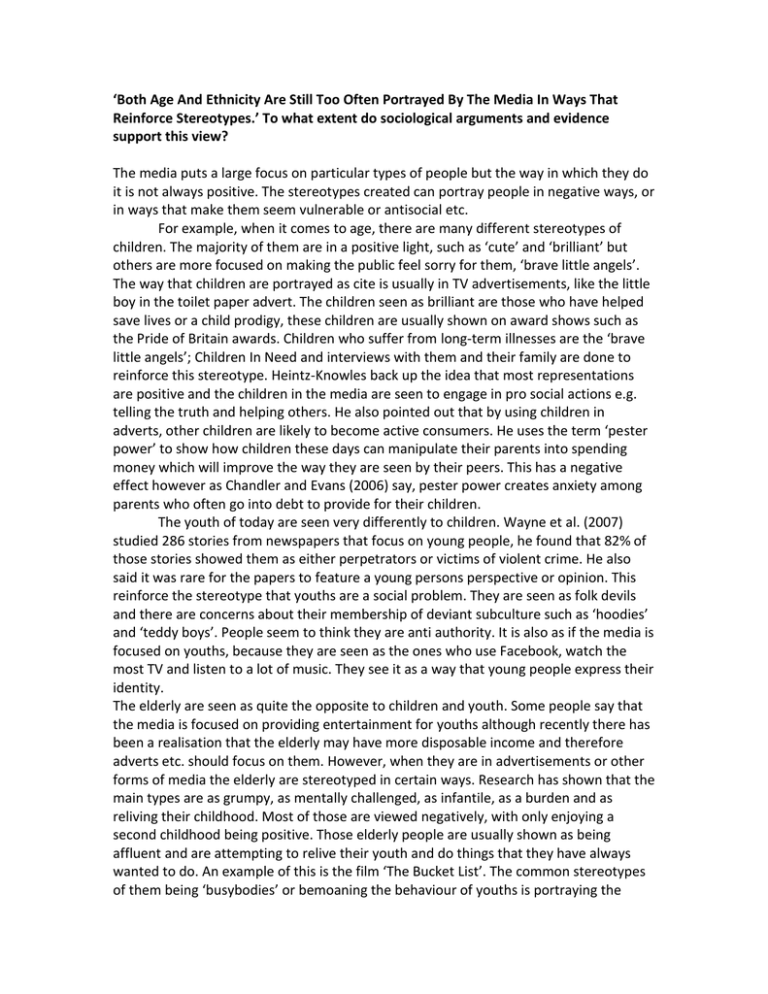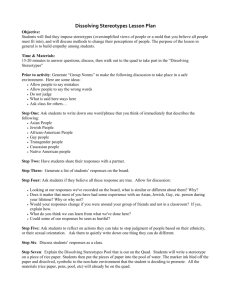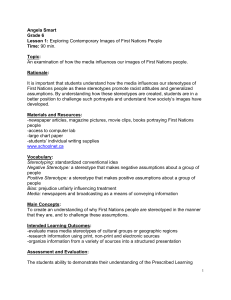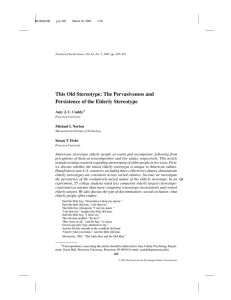'Both Age And Ethnicity Are Still Too Often Portrayed By The Media
advertisement

‘Both Age And Ethnicity Are Still Too Often Portrayed By The Media In Ways That Reinforce Stereotypes.’ To what extent do sociological arguments and evidence support this view? The media puts a large focus on particular types of people but the way in which they do it is not always positive. The stereotypes created can portray people in negative ways, or in ways that make them seem vulnerable or antisocial etc. For example, when it comes to age, there are many different stereotypes of children. The majority of them are in a positive light, such as ‘cute’ and ‘brilliant’ but others are more focused on making the public feel sorry for them, ‘brave little angels’. The way that children are portrayed as cite is usually in TV advertisements, like the little boy in the toilet paper advert. The children seen as brilliant are those who have helped save lives or a child prodigy, these children are usually shown on award shows such as the Pride of Britain awards. Children who suffer from long-term illnesses are the ‘brave little angels’; Children In Need and interviews with them and their family are done to reinforce this stereotype. Heintz-Knowles back up the idea that most representations are positive and the children in the media are seen to engage in pro social actions e.g. telling the truth and helping others. He also pointed out that by using children in adverts, other children are likely to become active consumers. He uses the term ‘pester power’ to show how children these days can manipulate their parents into spending money which will improve the way they are seen by their peers. This has a negative effect however as Chandler and Evans (2006) say, pester power creates anxiety among parents who often go into debt to provide for their children. The youth of today are seen very differently to children. Wayne et al. (2007) studied 286 stories from newspapers that focus on young people, he found that 82% of those stories showed them as either perpetrators or victims of violent crime. He also said it was rare for the papers to feature a young persons perspective or opinion. This reinforce the stereotype that youths are a social problem. They are seen as folk devils and there are concerns about their membership of deviant subculture such as ‘hoodies’ and ‘teddy boys’. People seem to think they are anti authority. It is also as if the media is focused on youths, because they are seen as the ones who use Facebook, watch the most TV and listen to a lot of music. They see it as a way that young people express their identity. The elderly are seen as quite the opposite to children and youth. Some people say that the media is focused on providing entertainment for youths although recently there has been a realisation that the elderly may have more disposable income and therefore adverts etc. should focus on them. However, when they are in advertisements or other forms of media the elderly are stereotyped in certain ways. Research has shown that the main types are as grumpy, as mentally challenged, as infantile, as a burden and as reliving their childhood. Most of those are viewed negatively, with only enjoying a second childhood being positive. Those elderly people are usually shown as being affluent and are attempting to relive their youth and do things that they have always wanted to do. An example of this is the film ‘The Bucket List’. The common stereotypes of them being ‘busybodies’ or bemoaning the behaviour of youths is portraying the elderly in a bad way, also by showing them as needing to rely on people for help creates a somewhat false image of what older people actually are like. When it comes to ethnicity there are a lot of stereotypes that may influence the public’s perception. Again, they are mainly negative for example they are often seen as a threat. This stereotype is mainly used for Muslims, especially since the 9/11 terrorist attacks and between 1995 and 1996 most representations of ethnic minorities in newspapers were as a threat to mainstream society, values and society. There is also the idea that they are abnormal due to the culture differences, for example, what Asians may consider to be normal we might not, this includes things such as arranged marriage and the style of clothing – the hijab and veil. A study by the BBC (2002) shows that Asian audiences were unhappy in the way the media failed to differentiate between Asian groups. All were put together and called Asian despite there being many different cultures and values. The stereotypes are not all negative though; ethnic minorities are often seen as good at entertainment. Agebetu (2006) says that black people are constructed by the media in 3 ways; these are crime, entertainment and sport. He says that they are not seen to be interested in anything else. There is the issue though, that the rapping that black people are usually good at promotes things such as violence, materialism, sexual objectification and misogyny. These things bring down some of the positive aspects to this stereotype. Being dependent is another form of stereotype. With the shows such as Comic Relief and G8, ethnic minorities come across as needing out money to survive and as if they cannot do anything without us. The Glasgow University Media Group says we focus on war etc. and seem to think that is it their own fault they’re in that situation. From this we can conclude that the media still too often stereotypes age and ethnicity and there is plenty of evidence to support it. Some people feel that tokenism us used and that they should show all different aspects of age and ethnicity but don’t really think of the consequences and whether they are actually realistic. The use of stereotypes however, does influence our opinions of these types of people and we are often guilty of being prejudiced because of them.




